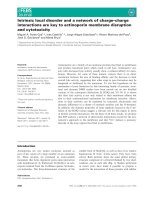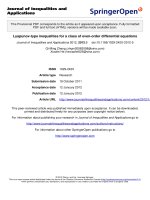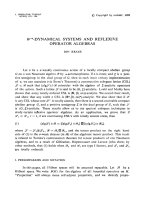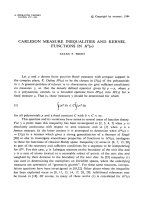Báo cáo toán học: "Weakly Self-Avoiding Words and a Construction of Friedman" ppt
Bạn đang xem bản rút gọn của tài liệu. Xem và tải ngay bản đầy đủ của tài liệu tại đây (96.53 KB, 4 trang )
Weakly Self-Avoiding Words and a Construction of
Friedman
Jeffrey Shallit
∗
and Ming-wei Wang
Department of Computer Science
University of Waterloo
Waterloo, Ontario, Canada N2L 3G1
Submitted: September 28, 2000; Accepted: February 7, 2001.
MR Subject Classifications: 68R15 Primary
Abstract
H. Friedman obtained remarkable results about the longest finite sequence x
over a finite alphabet such that for all i = j the word x[i 2i] is not a subsequence of
x[j 2j]. In this note we consider what happens when “subsequence” is replaced by
“subword”; we call such a sequence a “weakly self-avoiding word”. We prove that
over an alphabet of size 1 or 2, there is an upper bound on the length of weakly
self-avoiding words, while if the alphabet is of size 3 or more, there exists an infinite
weakly self-avoiding word.
1 Introduction
We say a word y is a subsequence of a word z if y can be obtained by striking out 0 or
more symbols from z. For example, “iron” is a subsequence of “introduction”. We say a
word y is a subword of a word z if there exist words w,x such that z = wyx. For example,
“duct” is a subword of “introduction”.
1
We use the notation x[k]todenotethek’th letter chosen from the string x. We write
x[a b] to denote the subword of x of length b − a + 1 starting at position a and ending at
position b.
Recently H. Friedman has found a remarkable construction that generates extremely
large numbers [1, 2]. Namely, consider words over a finite alphabet Σ of cardinality k.If
∗
Research supported in part by a grant from NSERC.
1
Europeans usually use the term “factor” for what we have called “subword”, and they sometimes use
the term “subword” for what we have called “subsequence”.
the electronic journal of combinatorics 8 (2001), #N2 1
an infinite word x has the property that for all i, j with 0 <i<jthe subword x[i 2i]is
not a subsequence of x[j 2j], we call it self-avoiding. We apply the same definition for a
finite word x of length n, imposing the additional restriction that j ≤ n/2.
Friedman shows there are no infinite self-avoiding words over a finite alphabet. Fur-
thermore, he shows that for each k there exists a longest finite self-avoiding word x over
an alphabet of size k. Call n(k) the length of such a word. Then clearly n(1) = 3 and
a simple argument shows that n(2) = 11. Friedman shows that n(3) is greater than the
incomprehensibly large number A
7198
(158386), where A is the Ackermann function.
Jean-Paul Allouche asked what happens when “subsequence” is replaced by “sub-
word”. A priori we do not expect results as strange as Friedman’s, since there are no
infinite anti-chains for the partial order defined by “x is a subsequence of y”, while there
are infinite anti-chains for the partial order defined by “x is a subword of y”.
2 Main Results
If an infinite word x has the property that for all i, j with 0 ≤ i<jthe subword x[i 2i]
is not a subword of x[j 2j], we call it weakly self-avoiding.Ifx is a finite word of length
n, we apply the same definition with the additional restriction that j ≤ n/2.
Theorem 1 Let Σ={0, 1, ,k− 1}.
(a) If k =1, the longest weakly self-avoiding word is of length 3, namely 000.
(b) If k =2, there are no weakly self-avoiding words of length > 13. There are 8 longest
weakly self-avoiding words, namely 0010111111010, 0010111111011, 0011110101010,
0011110101011 and the four words obtained by changing 0 to 1 and 1 to 0.
(c) If k ≥ 3, there exists an infinite weakly self-avoiding word.
Proof.
(a) If a word x over Σ = {0} is of length ≥ 4, then it must contain 0000 as a prefix.
Then x[1 2] = 00 is a subword of x[2 4] = 000.
(b) To prove this result, we create a tree whose root is labeled with , the empty word.
If a node’s label x is weakly self-avoiding, then it has two children labeled x0andx1.
This tree is finite if and only if there is a longest weakly self-avoiding word. In this case,
the leaves of the tree represent non-weakly-self-avoiding words that are minimal in the
sense that any proper prefix is weakly self-avoiding.
Now we use a classical breadth-first tree traversal technique, as follows: We maintain
a queue, Q, and initialize it with the empty word . If the queue is empty, we are done.
Otherwise, we pop the first element q from the queue and check to see if it is weakly
self-avoiding. If not, the node is a leaf, and we print it out. If q is weakly self-avoiding
then we append q0andq1 to the end of the queue.
the electronic journal of combinatorics 8 (2001), #N2 2
If this algorithm terminates, we have proved that there is a longest weakly self-avoiding
word. The proof may be concisely represented by listing the leaves in breadth-first order.
We may shorten the tree by assuming, without loss of generality, that the root is labeled
0.
When we perform this procedure, we obtain a tree with 92 leaves, whose longest label
is of length 14. The following list describes this tree:
0000 00111100 0011010101 001011111011
0001 00111110 0011010110 001011111100
0101 00111111 0011010111 001011111110
001000 01000000 0011101000 001011111111
001001 01000001 0011101001 001110101000
001010 01000010 0011101011 001110101001
001100 01000011 0011110100 001110101010
010001 01100001 0011110110 001110101011
010010 01100010 0011110111 001111010100
010011 01100011 0110000000 001111010110
011001 01110001 0110000001 001111010111
011010 01110010 0110000010 011100000000
011011 01110011 0110000011 011100000001
011101 0010110100 0111000001 011100000010
011110 0010110101 0111000010 011100000011
011111 0010110110 0111000011 00101111110100
00101100 0010110111 001011110100 00101111110101
00110100 0010111000 001011110101 00101111110110
00110110 0010111001 001011110110 00101111110111
00110111 0010111010 001011110111 00111101010100
00111000 0010111011 001011111000 00111101010101
00111001 0010111100 001011111001 00111101010110
00111011 0011010100 001011111010 00111101010111
Figure 1: Leaves of the tree giving a proof of Theorem 1 (b)
(c) Consider the word
x = 22010110111011111011111110111111111110 ···
= 220101
2
01
3
01
5
01
7
01
11
01
15
01
23
01
31
01
47
0 ···
where there are 0’s in positions 3, 5, 8, 12, 18, 26, 38, 54, 78, 110, 158, More precisely,
define f
2n+1
=5· 2
n
− 2forn ≥ 0, and f
2n
=7· 2
n−1
− 2forn ≥ 1. Then x has 0’s only
in the positions given by f
i
for i ≥ 1.
First we claim that if i ≥ 3, then any subword of the form x[i 2i] contains exactly two
0’s. This is easily verified for i =3.If5· 2
n
− 1 ≤ i<7 · 2
n
− 1andn ≥ 0, then there are
the electronic journal of combinatorics 8 (2001), #N2 3
0’s at positions 7 · 2
n
− 2and5· 2
n+1
− 2. (The next 0 is at position 7 · 2
n+1
− 2, which is
> 2(7 · 2
n
− 2).) On the other hand, if 7 · 2
n−1
− 1 ≤ i<5 · 2
n
− 1forn ≥ 1, then there
are 0’s at positions 5 · 2
n
− 2and7· 2
n
− 2. (The next 0 is at position 5 · 2
n+1
− 2, which
is > 2 · (5 · 2
n
− 2).)
Now we prove that x is weakly self-avoiding. Clearly x[1 2] = 22 is not a subword of
any subword of the form x[j 2j] for any j ≥ 2. Similarly, x[2 4] = 201 is not a subword
of any subword of the form x[j 2j] for any j ≥ 3. Now consider subwords of the form
t := x[i 2i]andt
:= x[j 2j]fori, j ≥ 3andi<j. From above we know t =1
u
01
v
01
w
,
and t
=1
u
01
v
01
w
.Fort to be a subword of t
we must have u ≤ u
, v = v
,andw ≤ w
.
But since the blocks of 1’s in x are distinct in size, this means that the middle block
of 1’s in t and t
must occur in the same positions of x.Thenu ≤ u
implies i ≥ j,a
contradiction.
3 Another construction
Friedman has also considered variations on his construction, such as the following: let
M
2
(n) denote the length of the longest finite word x over {0, 1} such that x[i 2i]isnot
a subsequence of x[j 2j]forn ≤ i<j. We can again consider this where “subsequence”
is replaced by “subword”.
Theorem 2 There exists an infinite word x over {0, 1} such that x[i 2i] is not a subword
of x[j 2j] for all i, j with 2 ≤ i<j.
Proof. Let
x = 001001
3
01
2
01
7
01
5
01
15
01
11
01
31
01
23
···
= 001001
g
1
01
g
2
01
g
3
0 ···
where g
1
=3,g
2
=2,andg
n
=2g
n−2
+1for n ≥ 3. Then a proof similar to that above
shows that every subword of the form x[i 2i] contains exactly two 0’s, and hence, since
the g
i
are all distinct, we have x[i 2i] is not a subword of x[j 2j]forj>i>1.
References
[1] H. Friedman. Long finite sequences. To appear, J. Combinat. Theory A. Also available
at < />[2] H. Friedman. Enormous integers in real life. Manuscript, dated June 1 2000, available
at < />the electronic journal of combinatorics 8 (2001), #N2 4









